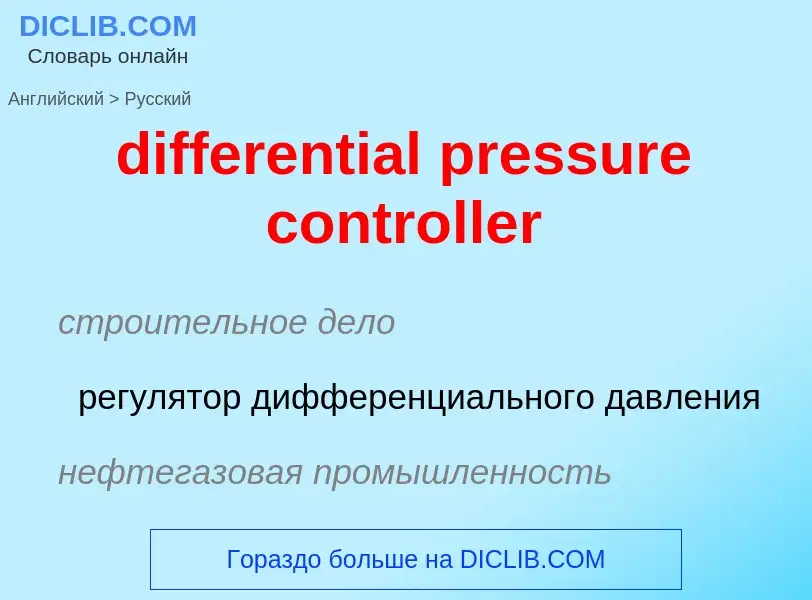Перевод и анализ слов искусственным интеллектом ChatGPT
На этой странице Вы можете получить подробный анализ слова или словосочетания, произведенный с помощью лучшей на сегодняшний день технологии искусственного интеллекта:
- как употребляется слово
- частота употребления
- используется оно чаще в устной или письменной речи
- варианты перевода слова
- примеры употребления (несколько фраз с переводом)
- этимология
differential pressure controller - перевод на русский
строительное дело
регулятор дифференциального давления
нефтегазовая промышленность
дифференциальный регулятор давления
общая лексика
дисковый контроллер, контроллер диска
плата расширения и/или микросхема, обеспечивающая взаимодействие процессора с дисковым накопителем
строительное дело
ПИД-регулятор, пропорционально-интегральный (изодромный) регулятор с предварением
строительное дело
ПИД-регулятор, пропорционально-интегральный (изодромный) регулятор с предварением
общая лексика
контроллер НГМД
['eəkəntrəulə]
синоним
Определение
Википедия

A pressure sensor is a device for pressure measurement of gases or liquids. Pressure is an expression of the force required to stop a fluid from expanding, and is usually stated in terms of force per unit area. A pressure sensor usually acts as a transducer; it generates a signal as a function of the pressure imposed. For the purposes of this article, such a signal is electrical.
Pressure sensors are used for control and monitoring in thousands of everyday applications. Pressure sensors can also be used to indirectly measure other variables such as fluid/gas flow, speed, water level, and altitude. Pressure sensors can alternatively be called pressure transducers, pressure transmitters, pressure senders, pressure indicators, piezometers and manometers, among other names.
Pressure sensors can vary drastically in technology, design, performance, application suitability and cost. A conservative estimate would be that there may be over 50 technologies and at least 300 companies making pressure sensors worldwide.
There is also a category of pressure sensors that are designed to measure in a dynamic mode for capturing very high speed changes in pressure. Example applications for this type of sensor would be in the measuring of combustion pressure in an engine cylinder or in a gas turbine. These sensors are commonly manufactured out of piezoelectric materials such as quartz.
Some pressure sensors are pressure switches, which turn on or off at a particular pressure. For example, a water pump can be controlled by a pressure switch so that it starts when water is released from the system, reducing the pressure in a reservoir.




.jpg?width=200)










![Early PID theory was developed by observing the actions of [[helmsmen]] in keeping a vessel on course in the face of varying influences such as wind and sea state. Early PID theory was developed by observing the actions of [[helmsmen]] in keeping a vessel on course in the face of varying influences such as wind and sea state.](https://commons.wikimedia.org/wiki/Special:FilePath/Scross helmsman.jpg?width=200)


![A setup disk of Japanese [[Microsoft Office]] 4.3, provided with 3.5" 1.2 MB and 1440 KB formats. A setup disk of Japanese [[Microsoft Office]] 4.3, provided with 3.5" 1.2 MB and 1440 KB formats.](https://commons.wikimedia.org/wiki/Special:FilePath/MS Office 4.3 Pro Japanese 1.44 MB floppy disk.jpg?width=200)



![Civilian air traffic controllers, [[Memphis International Airport]], 1962 Civilian air traffic controllers, [[Memphis International Airport]], 1962](https://commons.wikimedia.org/wiki/Special:FilePath/Civilian air traffic controllers, Memphis.jpg?width=200)
![Controllers often work from a control tower like this one at [[Birmingham Airport]], England Controllers often work from a control tower like this one at [[Birmingham Airport]], England](https://commons.wikimedia.org/wiki/Special:FilePath/Control tower at Birmingham Airport, England 27June2019 arp.jpg?width=200)
.jpg?width=200)
